Glandore Castle
Houses within 10km of this house
Displaying 66 houses.
Houses within 10km of Glandore Castle
Displaying 66 houses.
| House name | Description | |
|---|---|---|
| Lakelands | At the time of Griffith's Valuation, Richard Beecher was holding this property in fee when it was valued at £8 10s. Lewis noted Lakelands as the seat of T.J. Hungerford in 1837 while Leet states that it was the residence of Timothy O'Driscoll in 1814. Lakelands was included in the sale of the Beecher estate in the Encumbered Estates Court in February 1852. Reverend Isaac Reeves was the owner of a house here in 1906 which was valued at £20. In 1943 the Irish Tourist Association Survey noted that Lakelands had formerly been occupied by Hungerfords and Fergusons and was then the home of Mr. Kingston. The house is still extant. | |
| Hollybrook | At the time of Griffith's Valuation, John Beecher held two substantial properties in fee at Maulbrack. They were purchased in 1703 by Henry Beecher from the trustees for forfeited estates. In the early 1850s the larger was valued at £36 10s. In 1837 Lewis and Leet in 1814, had noted Hollybrook as the seat of Richard Beecher. It was offered for sale in the Encumbered Estates Court in 1851 and again in February 1852 and April 1858, when the sale notice included a lithograph and floor plan of the house. A plan of the demesne is also included. This house was also the seat of the Beecher family in the late 1770s and noted by Wilson as the seat of an earlier John Becher in 1786. Colonel Anthony Morgan was the owner of a property valued at £150 here in 1906 and The O'Donovan was resident in the mid 20th century. The original house is not extant but a later house exists at the site. |

|
| Lurriga House | Rev. Maurice Townsend was leasing this property to Rev. Richard Wright at the time of Griffith's Valuation, when it was valued at £27. The house is almost completely gone though some ruins remain. | |
| Lurriga Mill | James H. Swanton was leasing this property from Rev. Richard Wright at the time of Griffith's Valuation. It included a house valued at £8 10s and a mill valued at £88. In 1906 the representatives of Timothy M. Downing owned the property, then valued at £8. The house no longer exists but there are still buildings at the mill site. | |
| Rosebank | Thomas Marmion was leasing this property to Avisa Clarke at the time of Griffith's Valuation, when it was valued at £11 10s. The house at this site is labelled Russagh Cottage on the 1st edition Ordnance Survey map but as Rosebank on the 25-inch map of the 1890s.The National Inventory of Architectural Heritage states that the current house was built by the O'Donovan family in the 1860s as a dower house for Liss Ard House nearby. It is still extant and occupied. |
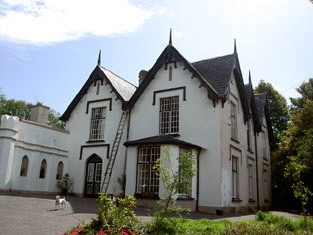
|
| Shepperton | John Townsend held this property in fee at the time of Griffith's Valuation, when it was valued at £20 10s. Noted by Lewis as the seat of M. Townsend in 1837 and by Leet as the residence of Jonas M. Townsend in 1814. Shepperton is still extant but in poor repair. |
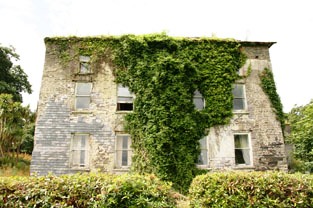
|
| Rinneen House & Mills | At the time of Griffith's Valuation, James Swanton was leasing a house valued at £9 at Carrigtishane from Rev, M. Townsend. A mill in the same location (W183333), held by Messers. Swanton, Goold and McNamara, was valued at £56. Information locally suggests that James Swanton built the house. Local sources claim the house was later used by the Catholic Church as the priest's house. It is now a ruin which was offered for sale in 2009. The mill buildings, now disused, are still extant. |
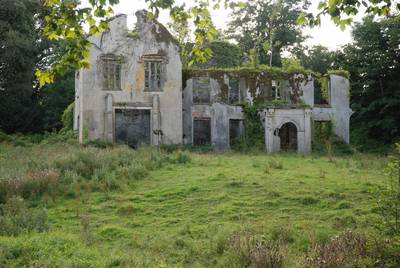
|
| Castle Townsend | Rev. Maurice Townsend held this property in fee at the time of Griffith's Valuation, when it was valued at £37. Lewis recorded it as the residence of Col. Townsend in 1837. In the later 1770s it was also the seat of the Townsend family. Wilson, writing in 1786, refers to Castle Townsend as the seat of Richard Townsend, "beautifully situated by Glandore Harbour". In 1906 it was owned by Charles L. Townsend and valued at £53. In 1945 the Irish Tourist Association Survey dated the present structure to 1860 noting that the previous house had been badly damaged by fire in 1858. It is still held by the family and accommodation is offered in part of the property. See http://www.castle-townshend.com. |

|
| Point House/Cosheen | John Somerville was leasing Point House from Rev. M. Townsend at the time of Griffith's Valuation, when it was valued at £20. Lewis recorded it as the seat of R.B. Townsend in 1837. It is labelled Point House on the 1st edition Ordnance Survey map but as Cosheen on the 25-inch edition of the 1890s. It is still extant and known by the latter title. | |
| Mall Cottage/House | John H. Townsend was leasing this property from Thomas Somerville at the time of Griffith's Valuation, when it was valued at £20. It is still extant. |
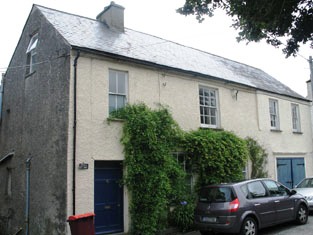
|
| Castletownsend (Coghill) | Sir Jocelyn Coghill was leasing this property from Rev. M. Townsend at the time of Griffith's Valuation, when it was valued at £22 10s | |
| Castletownsend (Herbert) | Mary Herbert was leasing this property from Rev. M. Townsend at the time of Griffith's Valuation, when it was valued at £25. There were a number of marriages between members of the Townsend family and the Herberts of Muckross, Killarney. | |
| Laputa/Glen Barrahane | Thomas Somerville was leasing this property to William Hicks at the time of Griffith's Valuation, when it was valued at £12. Gifford Lewis states that "Glen Barrahane was a rambling conglomeration of extensions to what was once a simple house called Laputa.". It became the home of the Coghill family later in the nineteenth century. | |
| Drishane | Thomas Somerville held this property in fee at the time of Griffith's Valuation when it was valued at £35. Lewis also recorded it as the seat of Thomas Somerville in 1837. In 1906 it was owned by Aylmer Somerville and valued at £35. The Irish Tourist Association Survey described it as having been home to Coghills, Townsends and Somervilles. In 1945 it was the home of Dr. Edith Somerville, the well known author and illustrator. It is still extant. |
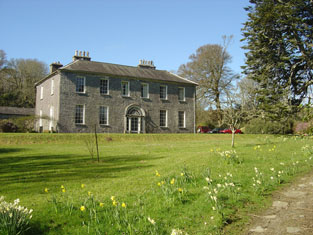
|
| Smithville | Rev. M. Townsend was leasing this property to Eleanor Townsend at the time of Griffith's Valuation, when it was valued at £12 10s. | |
| Smorane House | Sampson French was leasing this property to Gibbs Ross at the time of Griffith's Valuation, when it was valued at £8 10s. A house still exists at the site. | |
| Glenview | Samuel Levis was leasing this property from the Becher estate at the time of Griffith's Valuation, when it was valued at £18 10s. A house still exists at the site. | |
| Ballinatona Cottage | Daniel Welply was leasing this property to William Warren at the time of Griffith's Valuation, when it was valued at £13 5s. There is still an extant house at the site. | |
| Unionhall House | Colonel W.S. French was leasing a property valued at £28 to John Limerick, at the time of Griffith's Valuation. It was the residence of Col. W.Limerick in 1814. According to Townsend, Colonel Limerick had erected this "large and commodious dwelling" on his return from many years service with the East India Company. Union Hall is still extant and occupied. |

|
| Wood View | John Limerick was leasing this property to Robert Hungerford at the time of Griffith's Valuation, when it was valued at £8. The building is labelled Woodview dispensary on the 1st edition Ordnance Survey map and as Woodview on the 25-inch edition of the 1890s. There is a modern or renovated building at the site. | |
| Bawnlahan | Edward Powell held this property in fee at the time of Griffith's Valuation, when it was valued at £21. Lewis describes it as the residence of Major Powell in 1837. In the 1770s it was the seat of an O'Donovan family. Lt. Col. Henry Powell was the owner in 1906 when it was valued at £21. By 1945 the Irish Tourist Association Survey reported that it was the home of the O'Callaghan family who "had bought it from the Powells". Bawnlahan is still extant and occupied. |
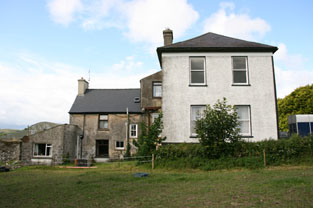
|
| Myross Cottage | At the time of Griffith's Valuation, Edward Powell was leasing this property to Rev. Robert Oliver, when it was valued at £15. The National Inventory of Architectural Heritage suggests it is of eighteenth century date. It is still extant and well maintained. |
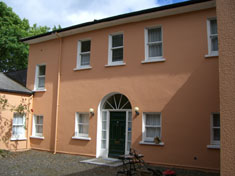
|
| Rock Cottage | Edward Powell was leasing a property to James Somerville,MD, at the time of Griffith's Valuation, when it was valued at £11 10s. In 1837 Lewis noted Capt. Somerville's seat as Union Hall. This house is labelled Rock Cottage on the 1st edition Ordnance Survey map but as Myross Glebe on the 25-inch edition of the 1890s. In 1945 the Irish Tourist Association survey recounted a story associating Dean Jonathan Swift with Rock Cottage and noting that it was the home of the Casey family. A house still exists at this site. | |
| Brade House | John Swanton was leasing this property from Rev. Maurice Townsend at the time of Griffith's Valuation, when it was valued at £15 10s. Lewis had noted it as the seat of Rev. E.P. Thompson in 1837. It was the residence of Samuel Jervois in 1814. Taylor and Skinner's 1783 map also indicate it as a Jervois residence. In 1786 Wilson refers to it as the seat of Mr.Jervis. In 1906 it was owned by Katherine Townsend and valued at £44 5s. There is still an extant house at the site. | |
| Myross Wood | John Townsend held this property in fee at the time of Griffith's Valuation, when it was valued at £45. Eugene Daly writes that the house was built by the Reverend Arthur Herbert, Vicar of Myross, who married Helena Townsend of Castletownsend. In the late 18th century the house was bought by the Earl of Kingston who enlarged it and lived in it while Mitchelstown Castle was being built. It reverted back to Townshend ownership in 1826 when purchased by John Sealy Townsend and remained in Townsend ownership until 1943. In 1944 the house was bought by the Cleary family. Sold to the Missionaries of the Sacred Heart in 1946, who now use the building as a Retreat Centre. |

|
| Seaview House (Myross) | Col. W.F. French was leasing this property to Richard Kingston at the time of Griffith's Valuation when it was valued at £9 15s. The family were still resident in 1911. The house is still extant and occupied. |

|
| Clontaff | Richard Townsend was leasing this property from Esther Horan at the time of Griffith's Valuation, when it was valued at £19. Lewis also records it as the seat of R. Townsend in 1837. | |
| Castle Eyre/Listarkin | At the time of Griffith's Valuation, Colonel W. French was leasing this property to William Lowth, when it was valued at £9 15s. It is labelled Castle Eyre on the 1st Edition Ordnance Survey Map but as Listarkin on the 25-inch map of the 1890s. It is still extant and occupied. |

|
| Squince House | At the time of Griffith's Valuation, John F. Townsend was leasing this property to Alexander Donovan, when it was valued at £9 10s. It is described as "in ruins" on the 25-inch Ordnance Survey map of the 1890s. In 1945 the Irish Tourist Association Survey noted that traces of the old walls and gardens of the O'Donovan property could still be seen but that the site was now occupied by a modern two-storey house, the residence of the Brown family. | |
| Skahanagh House | At the time of Griffith's Valuation, James Kingston was leasing this property from the French estate, when it was valued at almost £6. It is labelled Skahanagh House on the later 25-inch Ordnance Map. There is still a house at this site. | |
| Ballincolla House | At the time of Griffith's Valuation, Mary Warren was leasing a house at Ballincolla from John Limerick's estate, valued at £14. There is still an extant house at the site. | |
| Bunalunn or Mount Music | At the time of Griffith's Valuation, Rev. Richard Webb was leasing this property from Col. Clarke's estate, when it was valued at £10. Lewis had noted it as the seat of R.F. Webb. Leet refers to it as the seat of Alex O'Driscoll in 1814. In 1906 Capt. Anthony Morgan was the owner of this property, then valued at £26 5s. The house is named Mount Music on the 1st edition Ordnance Survey map but as Bunalunn on the 25-inch edition of the 1890s. AS Mount Music it gave its name to a novel by the celebrated Anglo-Irish writers, Somerville and Ross. The house is still extant and was offered for sale in recent years. | |
| Lakemount | John Callaghan was leasing this property from Edward Fuller at the time of Griffith's Valuation, when it was valued at £5 10s. There is still a house at the site. | |
| Liss Ard | Built in the later nineteenth century Lissard was owned by The O'Donovan and valued at £90 in 1906. The Irish Tourist Association survey of 1943 mentioned that it was then the property of John Connolly. It is still extant and offered as luxury accommodation. The gardens are open to the public. See www.lissardestate.com. |
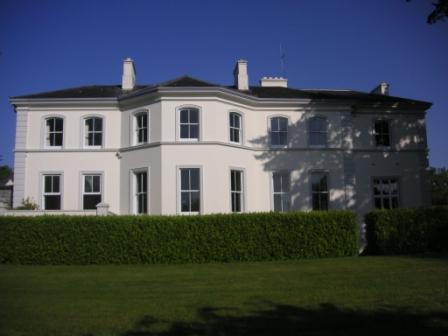
|
| Coppinger's Court | Built by Sir Walter Coppinger in the early seventeenth century and partially destroyed in the 1641 Rebellion. Described by Bence-Jones as an impressive semi-fortified house. By the mid nineteenth century it had fallen into ruin and is not mentioned in Griffith's Valuation, when the lessor of the surrounding land was Lady Carbery's estate. |
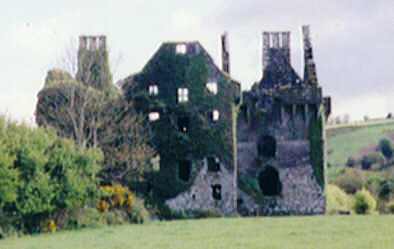
|
| Kilfinnan Castle | Occupied by John O'Brien, leasing from John de Burgh , at the time of Griffith's Valuation, when it was valued at £15. Noted in Lewis in 1837 as the residence of J. Ranclud. John French was occupying the house and demesne at Kilfinnin, barony of East Carbery, when it was offered for sale in the Encumbered Estates Court in May 1851. It is still extant and occupied. |

|
| Drombeg House | Drombeg was being leased by Catherine Jones from Lady Carbery's estate at the time of Griffith's Valuation, when it was valued at over £20. The sale notice of April 1852 includes a small lithograph of the house. In 1837 Lewis referred to Drombeg as the seat of Rev.Jonas Travers Jones. Leet refers to it in 1814 as the residence of John Baldwin. The house is still extant and occuped. See the Clonakilty Museum material at www.allaboutireland.ie |

|
| Lakeview (Kilfaughnabeg) | Leased by Martha Raclaud from the Baldwin estate in 1851 when it was valued at £8. It is labelled Lake View on both the First and 25-inch Ordnance survey maps. A house is still extant at this site. | |
| Shorecliffe House | Occupied by the Rev. William Baldwin at the time of Griffith's Valuation, when it was valued at £11. It is named Prospect House on the 1st-edition Ordnance Survey map but as Shorecliffe House on the 25-inchmap of the 1890s. It is still known by this name. It was offered for sale in 2015. |
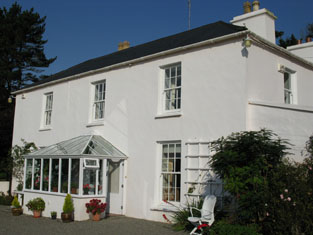
|
| West View (Glandore) | Leased by Francis Allen from Lords Longford and deVesci at the time of Griffith's Valuation, when it was valued at £21. The National Inventory of Architectural Heritage contends that Stone Hall is the earliest house of this group of three and that they were constructed by members of the Allen family. This house is labelled as West View on both the First and 25-inch edition Ordnance Survey maps. It is still extant and occupied. |
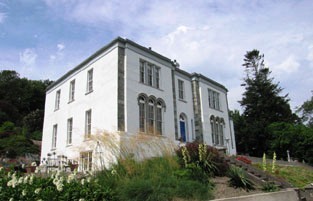
|
| West View | At the time of Griffith's Valuation, West View was being leased from Lords Longford and deVesci by Francis Allen, when it was valued at £21. Lewis refers to West View as the seat of Maj. E. Allen in 1837. It is still extant and occupied and now known as Seamark. |
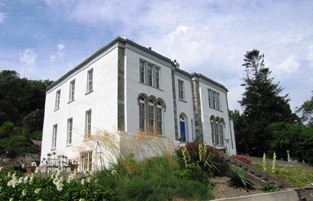
|
| Chateau Marie or East View | Held by Francis Allen but unoccupied in 1851 when it was valued at £30. Lewis refers to it as the seat of F. Allen in 1837. It is labelled Chateau Marie on the First Edition Ordnance Survey Map but as East View on the later 25-inch edition of the 1890s. Now a country house used for private functions. |

|
| Stone Hall | John Allen was leasing this property to Phillip Somerville in 1851 when it was valued at £26. Noted by Lewis as the seat of Maj. J. Allen in 1837. The house is still extant and occupied. |

|
| Glandore Lodge | Leased by Richard Adams from the Barry estate at the time of Griffith's Valuation, when it was valued at £14. Lewis refers to it as the seat of R. Adams in 1837. Though a building appears to exist at the site it is not named on the 25-inch Ordnance Survey map of the 1890s. A hotel is marked at the site. | |
| Glandore House | Leased by James R. Barry to Hon. Cecil Lawless in 1851 when it was valued at £26. . Noted by Lewis as the residence of J. R. Barry in 1837.The Irish Tourist Association survey of the 1940s noted that it had formerly been the residence of Isaac Morgan Reeves and later of Judge Coughlan but that it was vacant at that time. Still extant and offered for sale in 2010. |
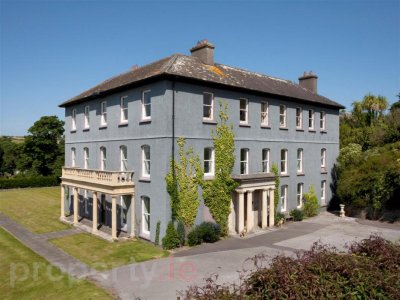
|
| Glandore Cottage | Leased by John Allen and others from the Barry estate in 1851 when it was valued at £10. Noted by Lewis as the residence of J.F. Townsend in 1837. James R. Barry also owned an unoccupied hotel at this location in 1851. Glandore Cottage is still extant. | |
| Millfield House (Ross) | This house, with a mill valued at £40, was leased by William Limerick to Henry Morrow in 1851, when the house was valued at £12 5s. Lewis notes Millfield as the seat of Lieut. Lloyd, RN, in 1837 while it is noted by Leet as the residence of Roger Sweeny in 1814. The mill is labelled Ross Mill on the 25-inch map of the 1890s. There is still an extant house at the site as well as the remains of some mill buildings. | |
| Cahermore House | In 1851 Thomas Hungerford was leasing Cahermore House from the Bishop of Cork's estate,when it was valued at £32. It was owned by Henry Hungerford in 1906 and valued at over £44. Taylor and Skinner's map of 1783 as well as Wilson in 1786 also mention Cahermore as a Hungerford residence. In 1944 the Irish Tourist Association Survey noted that Cahermore had been burnt during the War of Independence and was then derelict. Donnelly indicates that it was burnt in June 1921. It is no longer extant. | |
| Burgatia House | Leased by Robert Starkey from the estate of the Bishop of Cork at the time of Griffith's Valuation when it was valued at £12. Donnelly indicates that this house was occupied by Thomas Kingston when it was burnt in February 1921 during the War of Independence. It is no longer extant. | |
| Easton House | In 1851 Jane Smyth was leasing this property from the Bishop of Cork's estate when it was valued at £13 15s. | |
| Milleen | Rev.William Jennings was leasing this property from the Hungerford estate at the time of Griffith's Valuation, when it was valued at £19 15s. In 1944 the Irish Tourist Association Survey lists Milleen among the houses in the area which had been burnt during the War of Independence and were then derelict. It is no longer extant. | |
| Creggane House | Creggane House was in the possession of John [Lichfield] at the time of Griffith's Valuation when it was valued at almost £9. It was leased to Robert Starkey at the time. A more substantial house is shown on the later 25-inch map of the 1890s. In 1885 Walford described Francis Evans Bennett as of "Creggane". A house is still extant at the site. | |
| Derry House (Ross) | Family records indicate the original house at Derry was bought by Bryan Townsend, son of Richard, the Cromwellian officer, in the 1680s. This house was a short distance from the current house which was built by Reverend Horatio Townsend in the early years of the nineteenth century and was held in fee by Reverend Chambre Townsend in 1851 when it was valued at £44. Earlier, in 1786, Wilson referred to Derry as a Townsend seat. It was substantially damaged when it was burnt in April 1921 during the War of Independence. . At the time it was the residence of Alexander Sullivan, a well-known barrister. In 1944 the Irish Tourist Association Survey noted that it was still derelict following the 1921 burning. The centre portion of the house and a substantial farm still exist at the site. |

|
| Roury House | Occupied by William Bleazby at the time of Griffith's Valuation on lease from the Townsend estate and valued at £12 5s. In 1885 Walford refers to the seat of William J. Bleazby as Bleazby Hall. A house still exists at this site. | |
| Castle Downeen | James Courcey was leasing Castle Downeen from Rev. John Smyth in 1851 when it was valued at £23 10s. Lewis refers to the house as the seat of R. Smith in 1837. Shown as a Smith residence on Taylor and Skinner's 1783 map. In 1944 the Irish Tourist Association Survey refers to "Duneen" as "now a farmer's dwelling". It is now a ruin. | |
| Ross Abbey House (Rosscarbery) | Rev. John Hamilton was leasing this property from Elizabeth Jago at the time of Griffith's Valuation, when it was valued at £12. This house no longer exists. | |
| Cashel House (Kilmacabea) | William Wolfe was leasing this property, then valued at £12, from Miss Wheeler, at the time of Griffith's Valuation. Local records suggest the family were associated with this house since the eighteenth century. The original house is no longer extant and a modern house exists at the site now. | |
| Cloonkeen House (Kilmacabea) | Leased by Sarah Dorman to Florence McCarthy in 1851 when the house was valued at £9. A house still exists at the site. | |
| Brook Ville (Kilmacabea) | Leased by John Morris to John Hungerford at the time of Griffith's Valuation, when it was valued at almost £8, Marriage records for the area record it was later the residence of the Wolfe family. On the 25-inch Ordnance Survey map the building at the site is labelled Corran House. The National Inventory of Architectural Heritage describes the property as a miller's house. |

|
| Connonagh House | John Morris was leasing this property to Barbara Jago in 1852 when it was valued at almost £8. There is still an extant house at the site. |
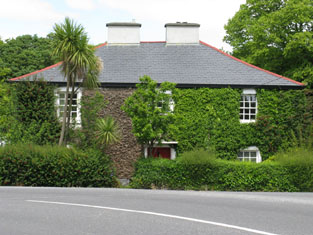
|
| Kilmacabea Mill | John Sheehan was leasing this property from the Bennett estate in 1852, when it was valued at almost £13 and included a mill. A corn mill, then disused, is shown on the 25-inch Ordnance Survey map of the 1890s. A building still exists at the site. | |
| Westwood/Benduff Cottage | Catherine French held this property from William Morris at the time of Griffith's Valuation. On the 25-inch Ordnance Survey map of the 1890s it is labelled Westwood. In 1906 it was owned by Michael French and valued at £13 10s. There is still an extant house at the site. | |
| Rosebank House | Rosebank House was built as a dower house for Liss Ard, possibly in the 1860s. It is still extant and occupied. | |
| Castle Salem | This property had formerly belonged to the McCarthys but was acquired by William Morris and re-named Castle Salem. In 1786 Wilson refers to it as the seat of the Morris family but by the publication of the first Ordnance Survey Map it is labelled "Benduff Castle or Castle Salem, in ruins". This property, developed over several centuries, is still extant and occupied. |
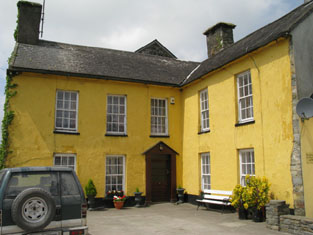
|
| Ballynagornagh House | In 1786 Wilson refers to "O'Barley-Hill" as a seat of Mr. Morris. At the time of the publication of the 1st Ordnance Survey the original Ballynagornagh House is described as "in ruins". However, a house has been restored on the site by the 1890s when it appears on the 25-inch Map. At the time of Griffith's Valuation, the townland was still in the possession of the Morris family though much of it was leased to the Donovans. The house was valued at £4 5s. A substantial farm occupies the site now. | |
| Cellmount House | Wilson, writing in 1786, refers to "Selmount House" as a seat of Mr. Morris, three miles from Ross Carbery. This property is labelled "Cellmount House, in ruins" on the 1st edition Ordnance Survey map and there is no trace of it on later maps. |

